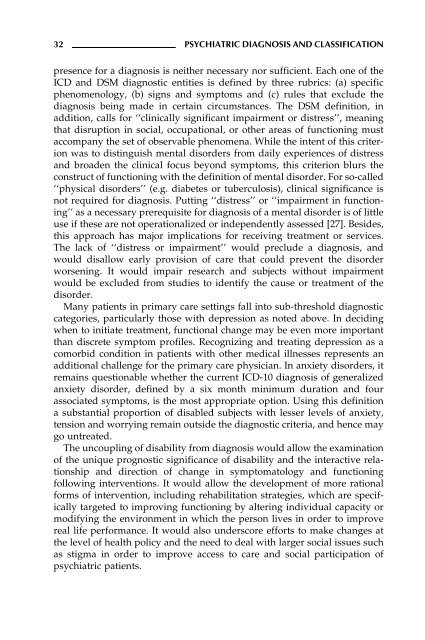Psychiatric Diagnosis and Classification - ResearchGate
Psychiatric Diagnosis and Classification - ResearchGate
Psychiatric Diagnosis and Classification - ResearchGate
You also want an ePaper? Increase the reach of your titles
YUMPU automatically turns print PDFs into web optimized ePapers that Google loves.
32 PSYCHIATRIC DIAGNOSIS AND CLASSIFICATION<br />
presence for a diagnosis is neither necessarynor sufficient. Each one of the<br />
ICD <strong>and</strong> DSM diagnostic entities is defined bythree rubrics: a) specific<br />
phenomenology, b) signs <strong>and</strong> symptoms <strong>and</strong> c) rules that exclude the<br />
diagnosis being made in certain circumstances. The DSM definition, in<br />
addition, calls for ``clinicallysignificant impairment or distress'', meaning<br />
that disruption in social, occupational, or other areas of functioning must<br />
accompanythe set of observable phenomena. While the intent of this criterion<br />
was to distinguish mental disorders from dailyexperiences of distress<br />
<strong>and</strong> broaden the clinical focus beyond symptoms, this criterion blurs the<br />
construct of functioning with the definition of mental disorder. For so-called<br />
``physical disorders'' e.g. diabetes or tuberculosis), clinical significance is<br />
not required for diagnosis. Putting ``distress'' or ``impairment in functioning''<br />
as a necessaryprerequisite for diagnosis of a mental disorder is of little<br />
use if these are not operationalized or independentlyassessed [27]. Besides,<br />
this approach has major implications for receiving treatment or services.<br />
The lack of ``distress or impairment'' would preclude a diagnosis, <strong>and</strong><br />
would disallow earlyprovision of care that could prevent the disorder<br />
worsening. It would impair research <strong>and</strong> subjects without impairment<br />
would be excluded from studies to identifythe cause or treatment of the<br />
disorder.<br />
Manypatients in primarycare settings fall into sub-threshold diagnostic<br />
categories, particularlythose with depression as noted above. In deciding<br />
when to initiate treatment, functional change maybe even more important<br />
than discrete symptom profiles. Recognizing <strong>and</strong> treating depression as a<br />
comorbid condition in patients with other medical illnesses represents an<br />
additional challenge for the primarycare physician. In anxietydisorders, it<br />
remains questionable whether the current ICD-10 diagnosis of generalized<br />
anxietydisorder, defined bya six month minimum duration <strong>and</strong> four<br />
associated symptoms, is the most appropriate option. Using this definition<br />
a substantial proportion of disabled subjects with lesser levels of anxiety,<br />
tension <strong>and</strong> worrying remain outside the diagnostic criteria, <strong>and</strong> hence may<br />
go untreated.<br />
The uncoupling of disabilityfrom diagnosis would allow the examination<br />
of the unique prognostic significance of disability<strong>and</strong> the interactive relationship<br />
<strong>and</strong> direction of change in symptomatology <strong>and</strong> functioning<br />
following interventions. It would allow the development of more rational<br />
forms of intervention, including rehabilitation strategies, which are specificallytargeted<br />
to improving functioning byaltering individual capacityor<br />
modifying the environment in which the person lives in order to improve<br />
real life performance. It would also underscore efforts to make changes at<br />
the level of health policy<strong>and</strong> the need to deal with larger social issues such<br />
as stigma in order to improve access to care <strong>and</strong> social participation of<br />
psychiatric patients.

















